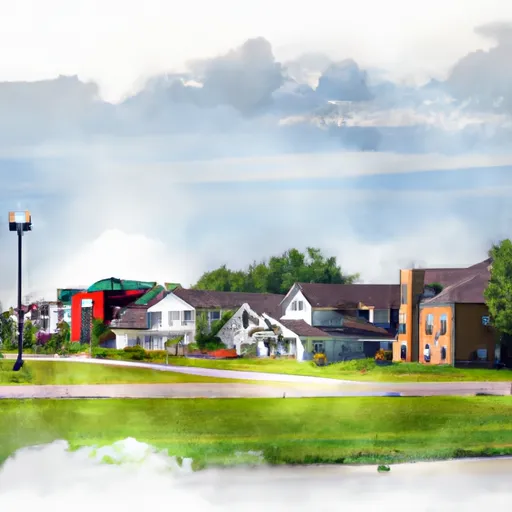-
 Snoflo Premium
Snoflo Premium
Get unlimited access to all our content
With no Ad interruptions! - Start Your Free Trial Login with existing account
Lake-Village
Eden Index
Climate
7.8
•
Recreation
3.5
•
Community
0.9
•
Safeguard
4.6/10

Lake Village, located in the state of Indiana, offers a diverse range of outdoor recreational opportunities within its beautiful surroundings. The climate in Lake Village is classified as humid continental, characterized by hot summers and cold winters. The average summer temperature is around 85°F (29°C), while winter temperatures can drop to approximately 20°F (-7°C).
The region is home to several lakes and rivers, including the Kankakee River, which flows through the town. These water bodies contribute to the hydrology of Lake Village and provide opportunities for fishing, boating, and other water-based activities. The Kankakee River State Park, located nearby, offers trails for hiking and biking, as well as camping facilities.
Lake Village boasts abundant outdoor recreational opportunities, such as birdwatching, hunting, and wildlife observation. The nearby Indiana Dunes National Park, a short drive from Lake Village, offers stunning sand dunes, hiking trails, and beaches along Lake Michigan.
In conclusion, Lake Village, Indiana, provides a diverse climate with hot summers and cold winters. Its hydrology constituents, including lakes and the Kankakee River, offer ample opportunities for fishing, boating, and water-based activities. With its proximity to the Indiana Dunes National Park, the region also offers various outdoor recreational opportunities, making it an ideal destination for nature enthusiasts.
What is the Eden Index?
The Snoflo Eden Index serves as a comprehensive rating system for regions, evaluating their desirability through a holistic assessment of climate health, outdoor recreation opportunities, and natural disaster risk, acknowledging the profound impact of these factors on livability and well-being.
Climate Health Indicator (CHI): 7.8
Lake-Village receives approximately
981mm of rain per year,
with humidity levels near 81%
and air temperatures averaging around
10°C.
Lake-Village has a plant hardyness factor of
5, meaning
plants and agriculture in this region thrive during a short period during spring and early summer. Most
plants will die off during the colder winter months.
By considering the ideal temperature range, reliable water supplies, clean air, and stable seasonal rain or snowpacks, the Climate Health Indicator (CHI) underscores the significance of a healthy climate as the foundation for quality living.
A healthy climate is paramount for ensuring a high quality of life and livability in a region, fostering both physical well-being and environmental harmony. This can be characterized by ideal temperatures, reliable access to water supplies, clean air, and consistent seasonal rain or snowpacks.
Weather Forecast
Streamflow Conditions
Upper Illinois
Area Rivers
Upper Illinois
Snowpack Depths
Upper Illinois
Reservoir Storage Capacity
Upper Illinois
Groundwater Levels
Recreational Opportunity Index (ROI): 3.5
The Recreational Opportunity Index (ROI) recognizes the value of outdoor recreational options, such as parks, hiking trails, camping sites, and fishing spots, while acknowledging that climate plays a pivotal role in ensuring the comfort and consistency of these experiences.
Access to outdoor recreational opportunities, encompassing activities such as parks, hiking, camping, and fishing, is crucial for overall well-being, and the climate plays a pivotal role in enabling and enhancing these experiences, ensuring that individuals can engage in nature-based activities comfortably and consistently.
Camping Areas
| Campground | Campsites | Reservations | Toilets | Showers | Elevation |
|---|---|---|---|---|---|
| Ouabache Trails County Park | 45 | 446 ft | |||
| Sullivan County Park | 450 | 520 ft | |||
| Res 26 - Greene - Sullivan State Forest | 25 | 498 ft | |||
| Lynnville Park | 70 | 465 ft | |||
| Scales Lake Park | 140 | 452 ft | |||
| Kimmell City Park | 10 | 415 ft | |||
| Greene - Sullivan State Forest | None | 521 ft | |||
| Destiny Parks Military - Fort Campbell | None | 544 ft | |||
| Prides Creek Co Park | None | 485 ft | |||
| Lincoln Trail | None | 412 ft |
Nearby Ski Areas
Catastrophe Safeguard Index (CSI):
The Catastrophe Safeguard Index (CSI) recognizes that natural disaster risk, encompassing floods, fires, hurricanes, and tornadoes, can drastically affect safety and the overall appeal of an area.
The level of natural disaster risk in a region significantly affects safety and the overall livability, with climate change amplifying these risks by potentially increasing the frequency and intensity of events like floods, fires, hurricanes, and tornadoes, thereby posing substantial challenges to community resilience and well-being.
Community Resilience Indicator (CRI): 0.9
The Community Resilience Indicator (CRI) recognizes that education, healthcare, and socioeconomics are crucial to the well-being of a region. The CRI acknowledges the profound impact of these elements on residents' overall quality of life. By evaluating educational resources, healthcare accessibility, and economic inclusivity, the index captures the essential aspects that contribute to a thriving community, fostering resident satisfaction, equity, and social cohesion.

